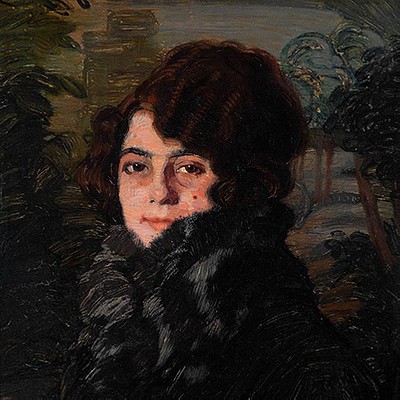RICARDO LOPEZ CABRERA (Cantillana, Seville, 1864 - Seville, 1950). "Door of the bread of Seville", 1893. Oil on panel.
Lot 48
About Seller
Setdart Auction House
Carrer Aragó 346
Barcelona
Spain
Setdart Subastas was born in 2004 and is currently the first online art auction in Spain with solidity, prestige and reliability guaranteed by our more than 60,000 users. Setdart has a young, dynamic and enterprising team ready to successfully manage the purchase and sale of art works through custom...Read more
Estimate:
EUR€16,000 - EUR€18,000
$17,204.30 - $19,354.84
Absentee vs Live bid
Two ways to bid:
- Leave a max absentee bid and the platform will bid on your behalf up to your maximum bid during the live auction.
- Bid live during the auction and your bids will be submitted real-time to the auctioneer.
Bid Increments
| Price | Bid Increment |
|---|---|
| EUR€0 | EUR€10 |
| EUR€200 | EUR€25 |
| EUR€500 | EUR€50 |
| EUR€1,000 | EUR€100 |
| EUR€3,000 | EUR€200 |
| EUR€5,000 | EUR€500 |
| EUR€10,000 | EUR€1,000 |
| EUR€20,000 | EUR€2,000 |
| EUR€50,000 | EUR€5,000 |
About Auction
By Setdart Auction House
Jul 15, 2021
Set Reminder
2021-07-15 08:00:00
2021-07-15 08:00:00
America/New_York
Bidsquare
Bidsquare : 19th & 20th CENTURY PAINTINGS & ORIENTALISM
https://www.bidsquare.com/auctions/setdart-auction-house/19th-20th-century-paintings-orientalism-7212
Setdart Auction House sofia@setdart.com
Setdart Auction House sofia@setdart.com
- Lot Description
RICARDO LOPEZ CABRERA (Cantillana, Seville, 1864 - Seville, 1950). "Door of the bread of Seville", 1893. Oil on panel. Signed, dated and located in the lower right corner. Measurements: 57 x 35.5 cm; 72.5 x 51 cm (frame). Scene of market where several groups of people gather to buy, it is interesting to note that the artist presents different popular characters, however they are only children, those who establish direct contact with the viewer. Thus contributing to the image, a certain innocence and joviality. Ricardo López Cabrera moved to Seville under the protection of Francisco Palazuelos, and there he developed his studies at the School of Fine Arts of Santa Isabel de Hungría in Seville, being a disciple of Eduardo Cano de la Peña. In 1887 he obtained from the Seville Provincial Council a post as a pensioner in Rome, where he extended his studies for four years, until 1892. On his return to Spain he establishes contact with the great painter José Jiménez Aranda, to whom he will feel truly united not only personally but also from the artistic point of view, as their aesthetic and cultural tastes coincide. Not very attached to prizes and honors, his work was exhibited, especially at the beginning of his career, in private circles, and later he participated in the National Exhibitions of Fine Arts of 1892 and 1895, being awarded on both occasions with a third class medal. At the international level he participated with four canvases in the Universal Exposition of Chicago in 1893. In 1906 he was named academician of merit of the Royal Academy of Fine Arts of Santa Isabel of Hungary and professor of drawing of his School, task that he will carry out until 1909, year in which he leaves to Argentina. There he taught at the Provincial School of Fine Arts in the city of Cordoba, and painted numerous portraits on commission. However, the realization in 1913 of a large allegorical canvas of more than eight meters for the ceiling of the Salón de Grados of the University of Cordoba, and its unrecoverable deterioration throughout the following decade, determined with a certain bitter spirit his return to Spain, and so in 1923 he returned to his homeland with the determination to make fifteen triptychs of a marked ethnographic character on the Spanish regional customs, following the example of "The Vision of Spain" that Sorolla had made for the Hispanic Society of New York. This work, conceived by purely personal impulse and carried out over a period of five years, was exhibited with great success in 1928 at the Círculo de Bellas Artes in Madrid. Ricardo López Cabrera's artistic production covered a wide range of themes, from landscape to genre painting and portraiture, as well as some orientalist paintings painted after a trip to Morocco. He is currently represented in the Prado Museum, the Carmen Thyssen Museum in Malaga, the Fine Arts Museums of Granada, Murcia and Seville, the Royal Academy of Fine Arts of Santa Isabel de Hungría in Seville and the Municipal Museum of Cordoba (Argentina), among many other centers.
- Shipping Info
-
In-house shipping available. Please inquire at admin@setdart.com.
-
- Buyer's Premium



 EUR
EUR CAD
CAD AUD
AUD GBP
GBP MXN
MXN HKD
HKD CNY
CNY MYR
MYR SEK
SEK SGD
SGD CHF
CHF THB
THB

















